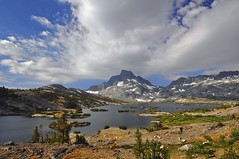 |
| Katie Tegtmeyer's flickr Photostream |
This is my experimental piece - The Story of Jessica. Jess is our latest addition to the family. Just like all the others, she was a surprise (I have to know people better before I share the personal details, but there is a humorous story for each child - only the ladies on my ringette team know them all!) What I share here is the arrival of Jessica (whom I really wanted to name Darby, my maiden name, but my husband couldn't get past picturing my dad and brother when he said the name). I used these pictures to create the VoiceThread, and to play with the voice recording and drawing tools. I don't start to experiment with the drawing tools until the last several slides, when I begin talking about the Corel PaintShop Photo Pro photo editing tools I was using (which I love - I have the Pro X2 version, but the newest version is the Pro X3 and was highly recommended in the workshop I took on Digital Storytelling with Bernajean Porter).
 |
| chucklepix (Steve)'s flickr photostream |
First, I created an account. I tried to set up the free Pro VoiceThread account - Berger and Trexler (2010) indicate the Pro account is available to teachers at no cost (p. 138) when you sign up with your school email. I set up the free account for now, but if I were to use in the classroom, I do recommend the Pro account - it allows you to create a protected account which all students can use (even if they are under the age of 13 which is the age required to set up their own accounts). This assures the privacy of the account and for the participants (Berger & Trexler, p. 138).
Next, I uploaded my pictures, arranged the order of the pictures and then added my voice recordings. I figured all of these steps out without tutorials and on my first try - the steps really are fail proof. I previewed my recordings and if I didn't like the recording I simply "cancelled" it and recorded a different one. After I was comfortable with that feature, I experimented with the drawing tool. Again, after the first or second use, it became a natural tool to use while recording your comment, enabling me to clearly identify which aspects of the slide I was referring to. It was similar to how I would teach using my Smartboard in my classroom.
I did look at a tutorial about Video Doodling and this is where I made my first attempt at participating in someone else's VoiceThread. I was able to post this VoiceThread to the sidebar of this blog using the embedding feature within VoiceThread. This feature makes it easy to share the VoiceThread on a number of different platforms. Just as a note, the VoiceThread was too large for my sidebar, but I was able to move it to different locations on my blog on the "design" page. I didn't like the location, so I copied the HTML text from the sidebar and inserted it into my blog. Below I have the inserted collaborative piece as well as the link.
With the basics of how to create and publish a VoiceThread out of the way, I began to explore how I would use this tool. VoiceThread has a Digital Library and Browse section which gives many examples. Again, it is a mash-up of tools such as Audacity and PowerPoint and other video tools, to create an enhanced presentation.
Berger and Trexler recommended Bill Ferriter's site and described it as a VoiceThread 101 site (2010, p. 135). His blog is Digitally Speaking and really does cover everything you need to understand VoiceThread and the possibilities for it. You will find resources for teaching students how to create a VoiceThread, proper etiquette, assessment tools and exemplars. It is a great site to include in your initial exploration.
Another blog with extensive information regarding the educational benefits of VoiceThread is InfoTech4Learning. The section is titled "VoiceThread in Teaching and Learning" and summarizes the uses as identified in several sources. Again, this is a site recommended by Berger and Trexler (2010, p. 136). Below is an excerpt from the section of "VoiceThread in Teaching and Learning" on InfoTech4Learning:
Benefits of VoiceThread according to Valenza and others:Finally, one last site Berger and Trexler (2010) recommend is Ned's Keeper "VoiceThread in the Classroom". This site gives 40 ideas of ways VoiceThread can be used in the classroom. Not to mention, it is a great site and is a member of Star Discovery Educator's Network.
 |
| emrank's flickr photostream |
 |
| mosman library's flickr photostream |
 |
| BlackBurnPhoto's flickr photostream |
The key ingredient with VoiceThread is the collaboration aspect. It is a "free online, asynchronous media tool [...]that permits the user to import and display a variety of media for the purpose of group discussion" (Berger & Trexler, p. 133). People can contribute thoughts and comments in several ways (phone, microphone, text, webcam, and audio) and can doodle on the slides. The creator of the VoiceThread can choose which comments to display, enhancing the learning in the presentation. Again, I refer back to the Artemis Fowl novel study. I recently did a class on the plot diagram. As a class we drew from the chapters we have already read to build pieces of the plot diagram. VoiceThread would have been a great place to collaboratively discuss and build the diagram. Further, it would be a great resource for students' final essays and projects for the novel study.
Breathing in deeply (happy I'm just breathing at all) and enjoying the trek! Moving forward with my sites set on the bigger picture - Google Earth!
References
Berger, P. & Trexler, S. (2010). Choosing web 2.0 tools for learning and teaching in a digital world. Sanata Barbara, CA: Libraries Unlimited.









